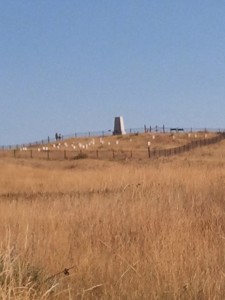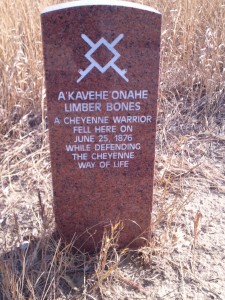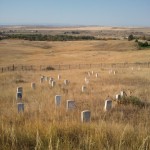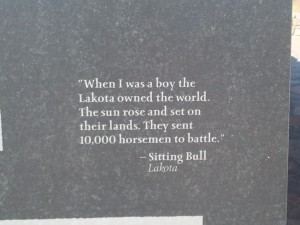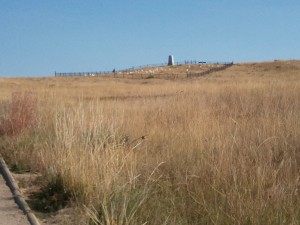This is a dry land. From atop Custer Ridge and Last Stand Hill the land drops to the south to the Little Big Horn River through coulees and ravines, almost all of it covered under this October sun with gray thistle and hairy golden aster, with prickly pear and gramma grass. To the north the ground continues to be broken and yellow with knee high grass – there are all kinds of nooks and gullies that the Sioux and Cheyenne, Arapaho, Sans Arcs and Blackfeet warriors would have used to hide and come closer with cover. The only trees are cottonwoods along the river and large cedars outlining the national cemetery. The sky is immense and blue.
My wife and I almost have the place to ourselves this morning. There are only a scattered few of us walking the bluffs and ravines and driving the length of the four mile battlefield. Charles Kuralt, a brilliant, long ago CBS news correspondent, once called this “the saddest place in America.” I remember the image of him while he said this. He was speaking under banks of gray clouds in a hard, constant wind. Something besides sadness is my animating force today, especially when four western meadow larks are singing near us. We heard their fluty, sweet song, rising and falling, off and on, all morning. That song and the wind and the whisper of trucks’ tires on I-90 – those are the only sounds. My wife, Patti, said “these places always make people quiet.” We too are quiet.
The cavalrymen’s graves on Last Stand Hill are indicated by white headstones, grouped in the clumps where they fell, encircled by a low fence. Custer’s headstone has dark lettering. From here a ribbon of headstones descends into ravines toward the river. Here and there granite markers give the name of Native American warriors who died in battle.
We walked the paths and touched some of the stones. It seemed necessary to touch them. Here is where this man fell, this individual person, on this broiling afternoon on June 25, 1876, a battle that lasted, according to NA oral histories, “as long as it takes a hungry man to eat a meal.” A few names: Henry Dose and Patrick Corcoran, Myles Keogh, Boston Custer, Eli Clair, Julius Helmer, the Arikara scouts Bloody Knife and BobTailed Bull and all told 268 soldiers, civilians and scouts of the 7th cavalry.No one knows for sure how many Native Americans died in the battle – somewhere between one and two hundred perhaps. The living took the bodies of the dead with them. NA oral tradition tells that most warriors died on Last Stand Hill. A few names: Lame White Man, Noisy Walking, Long Road, Dog’s Back Bone.
We rode to Benteen and Reno’s end of the battlefield. Benteen’s cool command under fire likely saved them — that and their soldiers made it to the top of the hill; their lines were not broken. Crazy Horse, the great war leader of the Hunkpapa Sioux, personally broke Custer’s right flank on Last Stand Hill, charging through it, horsed and swinging a war club. After that warriors and soldiers fought all mixed up in a mess of dead and dying horses, screams and dust. It was very hot. Warriors blew on eagle bone whistles. The air would have been thick with the smell of gunpowder. A range of bluffs separates Custer’s battle from Benteen’s site. Neither could see what was happening to the other.
The grasslands of Montana are unlike Gettysburg, the other deeply iconic American battlefield, where it can sometimes be difficult to envision the range of movement and the ebb and flow of battle because it was fought over three days and involved about 150,000 combatants ranging over 25 square miles, often under heavy tree cover. Little Big Horn stretches from the river, almost always in sight, to the ridge line and along the ridge for four, thin miles. Here you can see the bluffs and ravines. You can chart the movements of warrior and cavalryman. This battle compressed time and space. The grasslands remain as they were. Here you can capture the essence of that struggle and keep it in place in your imagination.This is tragic ground in the oldest sense– we can hold the names of many of the participants in our heads. They have not become statistics. The long dead do not overwhelm those of us who climb these hills now. Those names still have the power to inhabit that mystic element within us that gives flesh and dreams and histories to the men who fought on this broken ground. This stripped down place remains charged, alive with visions and names. Little Big Horn is The Iliad come to life in late 19th century America.
I felt a weight in the quiet, a somber quiet also within me. That came close to the end of our time when I found the memorial to the “…39 … horses shot for breast works.” The 7th cavalry dedicated a horse cemetery on this hilltop. Later I looked at the casualty lists – 1 saddler, 4 farriers and 1 blacksmith died on this ridge. The image crystalized – civilians attached to the cavalry, their only job to tend to animals who knew their touch and their voices — at the end fighting and dying with their horses. So many of the images we carry in our heads about this battle have been shaped by movies and paintings. Not this one. This image unlocked my heart.
At the end of the day I walked into the national cemetery where veterans of the Indian wars up to the Korean War are buried. It is green and well-watered within the circle of the cedar trees. I stopped at the small obelisk erected for James Davis, “erected by his comrades.” Who of us would not like to enter the next life with that sentiment echoing within our hearts?
The meadowlarks were resting among the tombstones and monuments. The land stretched out and away. I do not completely understand how it is possible to love places of such blood and pain and waste. I just know that I do. Perhaps because the land was also witness to honor and incalculable courage. I do not completely understand, but I felt raised up among those trees, astonished to belong to the same species as the men who rode into this country one hundred and thirty five years ago.
